Response Characteristics of Chinese Pine (Pinus tabulaeformis Carr.) Radial Growth to Climate and Drought Variability Reconstruction in Western Liaoning, Northeast China
Abstract
1. Introduction
2. Materials and Methods
2.1. Study Area and Climate
2.2. Tree-Ring Data
2.3. Statistical Analyses
3. Results
3.1. Statistics of Tree-Ring Width Chronology
3.2. Correlations between Chronologies and Climatic Variables
3.3. Variations in the Reconstructed scPDSI Index
4. Discussion
4.1. Climate–Growth Relationship
4.2. Regional Drought Signals and Teleconnection
5. Conclusions and Perspectives
Supplementary Materials
Author Contributions
Funding
Acknowledgments
Conflicts of Interest
References
- State Forestry Administration of China (SFA). Bulletion of the Fifth Desertification and Sandification State of China; State Forestry Administration: Beijing, China, 2015. [Google Scholar]
- Shi, K.H. Construction and countermeasures of three-north shelterbelt in Liaoning. Prot. Sci. Technol. 2016, 4, 85–86. (In Chinese) [Google Scholar]
- Jiao, S.R. Report on the causes of the early decline of Pinus sylvestris var. mongolica shelterbelt and its preventative and control measures in Zhanggutai of Liaoning province. Sci. Silva. Sin. 2001, 37, 131–138. [Google Scholar]
- Jiang, F.Q.; Yu, Z.Y.; Zeng, D.H. An ecological perspective of afforesting Chinese pine (Pinus tabulaeformis) plantations in western Liaoning Province. Chin. J. Ecol. 2007, 26, 2069–2074. [Google Scholar]
- Xu, H.C. Chinese Pine (Pinus tabulaeformis Carr.); Chinese Forest Press: Beijing, China, 1993. [Google Scholar]
- Zhao, Y.M. Present situation, problems and management countermeasures of Pinus tabulaeformis plantations in Western Liaoning. Prot. Sci. Technol. 2015, 2, 54. [Google Scholar]
- Lei, Q.D.; Liu, M.J.; Liu, J.Y. An approach of transforming the artificial forest of Chinese pine into the mixed broadleaf-pine forest in the hilly areas of Western Liaoning. Chin. J. Ecol. 1997, 16, 8–13. [Google Scholar]
- Wang, S.Z.; Li, S.M. Benefit analysis of issuing mixed forest of Pinus tabulaeformis forest in semi-arid area. Sci. Technol. 1999, 6, 22–24. [Google Scholar]
- Wu, X.X.; Han, L.C. Geographical distribution and suitability division of Pinus tabulaeformis. J. Soil Water Conserv. 2000, 14, 18–23. [Google Scholar]
- Zhang, Z. Tree-rings, a key ecological indicator of environment and climate change. Ecol. Indic. 2015, 51, 107–116. [Google Scholar] [CrossRef]
- Liu, Y.; Wang, Y.; Li, Q.; Song, H.; Zhang, Y.; Yuan, Z.; Wang, Z. A tree-ring based June–September mean relative humidity reconstruction since 1837 from the Yiwulü Mountain region, China. Int. J. Clim. 2015, 35, 1301–1308. [Google Scholar] [CrossRef]
- Liang, E.; Eckstein, D.; Liu, H. Climate-growth relationships of relict Pinus tabulaeformis at the northern limit of its natural distribution in northern China. J. Veg. Sci. 2008, 19, 393–406. [Google Scholar] [CrossRef]
- Cai, Q.; Liu, Y.; Lei, Y.; Bao, G.; Sun, B. Reconstruction of the March–August PDSI since 1703 AD based on tree rings of Chinese pine (Pinus tabulaeformis Carr.) in the Lingkong Mountain, southeast Chinese loess Plateau. Clim. Past 2014, 10, 509–521. [Google Scholar] [CrossRef]
- Fang, K.; Guo, Z.; Chen, D.; Linderholm, H.W.; Li, J.; Zhou, F.; Guo, G.; Dong, Z.; Li, Y. Drought variation of western Chinese Loess Plateau since 1568 and its linkages with droughts in western North America. Clim. Dyn. 2017, 49, 3839–3850. [Google Scholar] [CrossRef]
- Liu, N.; Bao, G.; Liu, Y.; Linderholm, H.W. Two centuries-long streamflow reconstruction inferred from tree rings for the middle reaches of the Weihe River in Central China. Forests 2019, 10, 208. [Google Scholar] [CrossRef]
- Li, Q.; Liu, Y.; Nakatsuka, T.; Song, H.; McCarroll, D.; Yang, Y.; Qi, J. The 225-year precipitation variability inferred from tree-ring records in Shanxi Province, the North China, and its teleconnection with Indian summer monsoon. Glob. Planet. Chang. 2015, 132, 11–19. [Google Scholar] [CrossRef]
- Yang, B.; Kang, S.; Ljungqvist, F.C.; He, M.; Zhao, Y.; Qin, C. Drought variability at the northern fringe of the Asian summer monsoon region over the past millennia. Clim. Dyn. 2014, 43, 845–859. [Google Scholar] [CrossRef]
- Chen, Z.; He, X.; Cook, E.R.; He, H.S.; Chen, W.; Sun, Y.; Cui, M. Detecting dryness and wetness signals from tree-rings in Shenyang, Northeast China. Palaeogeogr. Palaeoclimatol. Palaeoecol. 2011, 302, 301–310. [Google Scholar] [CrossRef]
- Zhao, H.L.; Zhao, X.Y.; Zhang, TH.; Zhou, R.L. Boundary line on agro-pasture zigzag zone in north China and its problems on eco-environment. Adv. Earth Sci. 2002, 17, 739–747. [Google Scholar]
- Song, L.; Zhu, J.; Li, M.; Zhang, J.; Lv, L. Sources of water used by Pinus sylvestris var. mongolica trees based on stable isotope measurements in a semiarid sandy region of Northeast China. Agric. Water Manag. 2016, 164, 281–290. [Google Scholar] [CrossRef]
- Fritts, H.C. Tree-Rings and Climate; Academic Press: London, UK, 1976. [Google Scholar]
- Cook, E.R.; Kairiukstis, L.A. Methods of Dendrochronology: Applications in the Environmental Sciences; Kluwer Academic Publishers: Boston, MA, USA, 1990. [Google Scholar]
- Holmes, R.L. Computer-assisted quality control in tree-ring dating and measurement. Tree Ring Bull 1983, 43, 69–95. [Google Scholar]
- Wigley, T.; Briffa, K.R.; Jones, P.D. On the average value of correlated time series, with applications in dendroclimatology and hydrometeorology. J. Appl. Meteorol. Climatol. 1984, 23, 201–213. [Google Scholar] [CrossRef]
- Wells, N.; Goddard, S.; Hayes, M.J. A self–calibrating palmer drought severity index. J. Clim. 2004, 17, 2335–2351. [Google Scholar] [CrossRef]
- Mitchell, T.D.; Jones, P.D. An improved method of constructing a database of monthly climate observations and associated high-resolution grids. Int. J. Climatol. 2005, 25, 693–712. [Google Scholar] [CrossRef]
- Smith, T.M.; Reynolds, R.W.; Peterson, T.C.; Lawrimore, J. Improvements to NOAA’s historical merged land-ocean surface temperature analysis (1880–2006). J. Clim. 2008, 21, 2283–2296. [Google Scholar] [CrossRef]
- Mann, M.E.; Lees, J. Robust estimation of background noise and signal detection in climatic time series. Clim. Chang. 1996, 33, 409–445. [Google Scholar] [CrossRef]
- Torrence, C.; Compo, G.P. A practical guide to wavelet analysis. Bull. Am. Meteorol. Soc. 1998, 79, 61–78. [Google Scholar] [CrossRef]
- McCarroll, D.; Young, G.H.F.; Loader, N.J. Measuring the skill of variance-scaled climate reconstructions and a test for the capture of extremes. Holocene 2015, 25, 618–626. [Google Scholar] [CrossRef]
- Liang, E.Y.; Liu, X.H.; Yuan, Y.J.; Qin, N.S.; Fang, X.Q.; Huang, L.; Zhu, H.F.; Wang, L.L.; Shao, X.M. The 1920s drought recorded by tree rings and historical documents in the semi-arid and arid areas of Northern China. Clim. Chang. 2006, 79, 403–432. [Google Scholar] [CrossRef]
- Luo, M.; Feng, J.; Xu, Z.; Wang, Y.; Dan, L. Evaluating the performance of five twentieth-century reanalysis datasets in reproducing the severe drought in northern China during the 1920s–1930s. Theor. Appl. Climatol. 2018. [Google Scholar] [CrossRef]
- Feng, S.; Hu, Q.; Wu, Q.; Mann, M.E. A gridded reconstruction of warm season precipitation for Asia spanning the past half millennium. J. Clim. 2013, 26, 2192–2204. [Google Scholar] [CrossRef]
- Yi, L.; Yu, H.; Ge, J.; Lai, Z.; Xu, X.; Qin, L.; Peng, S. Reconstructions of annual summer precipitation and temperature in north-central China since 1470 AD based on drought/flood index and tree-ring records. Clim. Chang. 2012, 110, 469–498. [Google Scholar] [CrossRef]
- Qian, W.; Lin, X.; Zhu, Y.; Xu, Y.; Fu, J. Climatic regime shift and decadal anomalous events in China. Clim. Chang. 2007, 84, 167–189. [Google Scholar] [CrossRef]
- Bao, G.; Liu, Y.; Liu, N.; Linderholm, H.W. Drought variability in eastern Mongolian Plateau and its linkages to the large-scale climate forcing. Clim. Dyn. 2015, 44, 717–733. [Google Scholar] [CrossRef]
- Wang, H.J. The weakening of the Asian monsoon circulation after the end of 1970′s. Adv. Atmos. Sci. 2001, 18, 376–386. [Google Scholar]
- Ma, Z.G. The interdecadal trend and shift of dry/wet over the central part of North China and their relationship to the Pacific decadal oscillation (PDO). Chin. Sci. Bull. 2007, 52, 2130–2139. [Google Scholar] [CrossRef]
- Ding, Y.; Sun, Y.; Wang, Z.; Zhu, Y.; Song, Y. Interdecadal variation of the summer precipitation in China and its association with decreasing Asian summer monsoon. Part II: Possible causes. Int. J. Climatol. 2009, 29, 1926–1944. [Google Scholar] [CrossRef]
- Qian, C.; Zhou, T. Multidecadal variability of North China aridity and its relationship to PDO during 1900–2010. J. Clim. 2014, 27, 1210–1222. [Google Scholar] [CrossRef]
- Liu, N.; Liu, Y.; Bao, G.; Bao, M.; Wang, Y.; Zhang, L.; Ge, Y.; Bao, W.; Tian, H. Drought reconstruction in eastern Hulun Buir steppe, China and its linkages to the sea surface temperatures in the Pacific Ocean. J. Asian Earth Sci. 2016, 115, 298–307. [Google Scholar] [CrossRef]
- Yang, Q.; Ma, Z.G.; Fan, X.G.; Yang, Z.L.; Xu, Z.F.; Wu, P.L. Decadal modulation of precipitation patterns over eastern China by sea surface temperature anomalies. J. Clim. 2017, 30, 7017–7033. [Google Scholar] [CrossRef]
- Wu, G.X.; Li, Z.Q.; Fu, C.B.; Zhang, X.Y.; Zhang, R.Y.; Zhang, R.H.; Zhou, T.J.; Li, J.P.; Li, J.D.; Zhou, D.G.; et al. Advances in studying interactions between aerosols and monsoon in China. Sci. China Earth Sci. 2016, 59, 1–6. [Google Scholar] [CrossRef]
- Li, S.; Wang, T.; Solmon, F.; Zhuang, B.; Wu, H.; Xie, M.; Han, Y.; Wang, X. Impact of aerosols on regional climate in southern and northern China during strong/weak East Asian summer monsoon years. J. Geophys. Res. Atmos. 2016, 121, 4069–4081. [Google Scholar] [CrossRef]
- Liu, X.D.; Xie, X.N.; Yin, Z.Y.; Liu, C.H.; Gettelman, A. A modeling study of the effects of aerosols on clouds and precipitation over East Asia. Theor. Appl. Climatol. 2011, 106, 343–354. [Google Scholar] [CrossRef]
- Liu, Y.; Cai, W.J.; Sun, C.F.; Song, H.M.; Cobb, K.; Li, J.P.; Leavitt, S.; Wu, L.X.; Cai, Q.F.; Liu, R.S.; et al. Anthropogenic aerosols cause recent pronounced weakening of Asian Summer Monsoon relative to last four centuries. Geophysic. Res. Lett. 2019. [Google Scholar] [CrossRef]
- Mantua, N.J.; Hare, S.R.; Zhang, Y.; Wallace, J.M.; Francis, R.C. A Pacific interdecadal climate oscillation with impacts on salmon production. Bull. Am. Meteorol. Soc. 1997, 78, 1069–1080. [Google Scholar] [CrossRef]
- Felis, T.; Suzuki, A.; Kuhnert, H.; Rimbu, N.; Kawahata, H. Pacific decadal oscillation documented in a coral record of North Pacific winter temperature since 1873. Geophysic. Res. Lett. 2010, 37, L14605. [Google Scholar] [CrossRef]
- Allan, R.; Lindesay, J.; Parker, D. El Nino: Southern Oscillation and ClimaticVariability; CSIRO Publishing: Collinwood, Australia, 1996. [Google Scholar]
- Gergis, J.L. Fowler, A.M. A history of ENSO events since A.D. 1525: Implications for future climate change. Clim. Chang. 2009, 92, 343–387. [Google Scholar] [CrossRef]
- Hu, Y.; Bao, G.; Liu, N.; Qu, Y. May–July mean minimum temperature variability in the mid-Qinling Mountains, central China, since 1814 CE. Quat. Int. 2018, 476, 102–109. [Google Scholar] [CrossRef]
- Zhang, Y.; Tian, Q.H.; Guillet, S.; Stoffel, M. 500-yr precipitation variability in Southern Taihang Mountains, China, and its linkages to ENSO and PDO. Clim. Chang. 2017, 144, 419–432. [Google Scholar] [CrossRef]
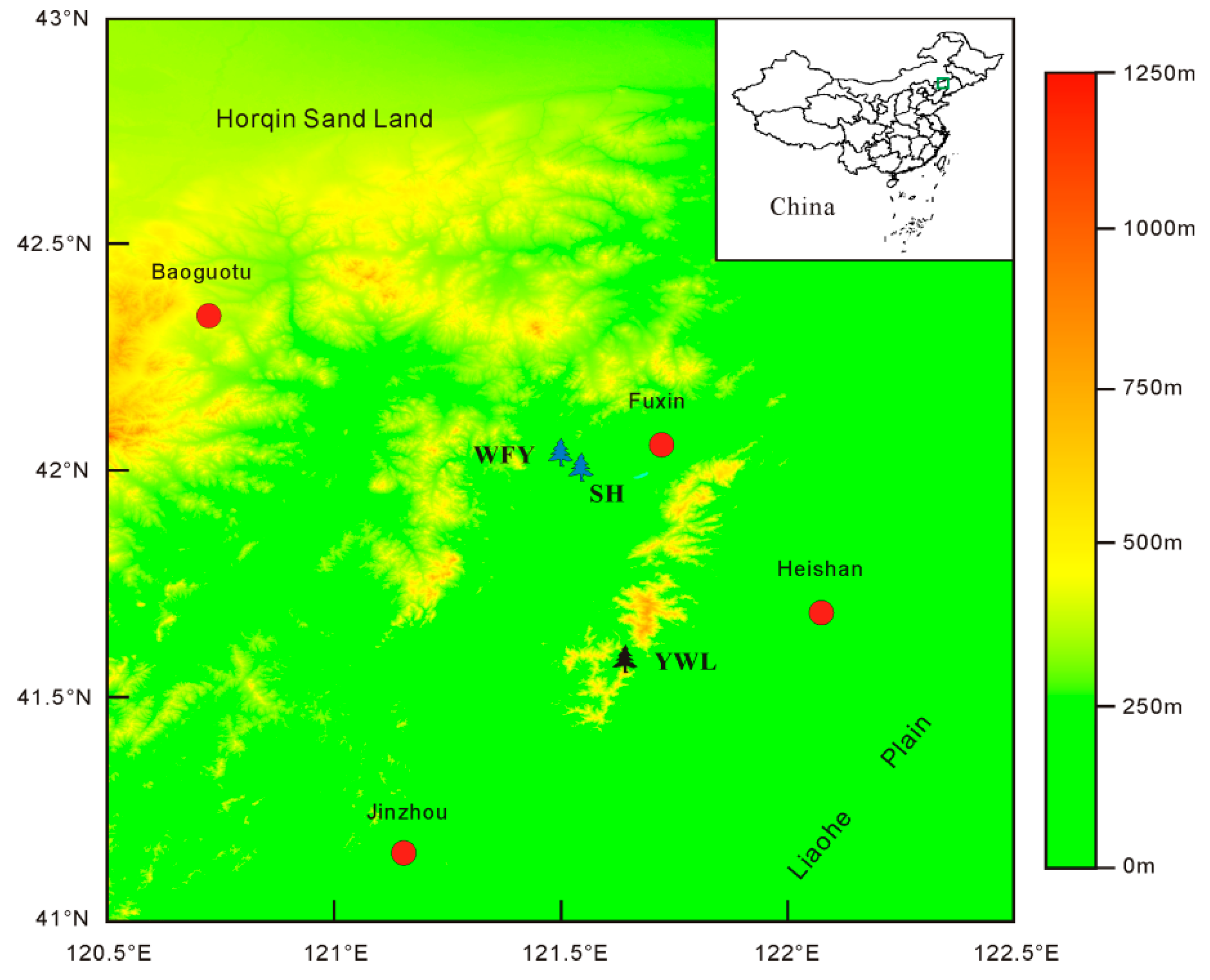
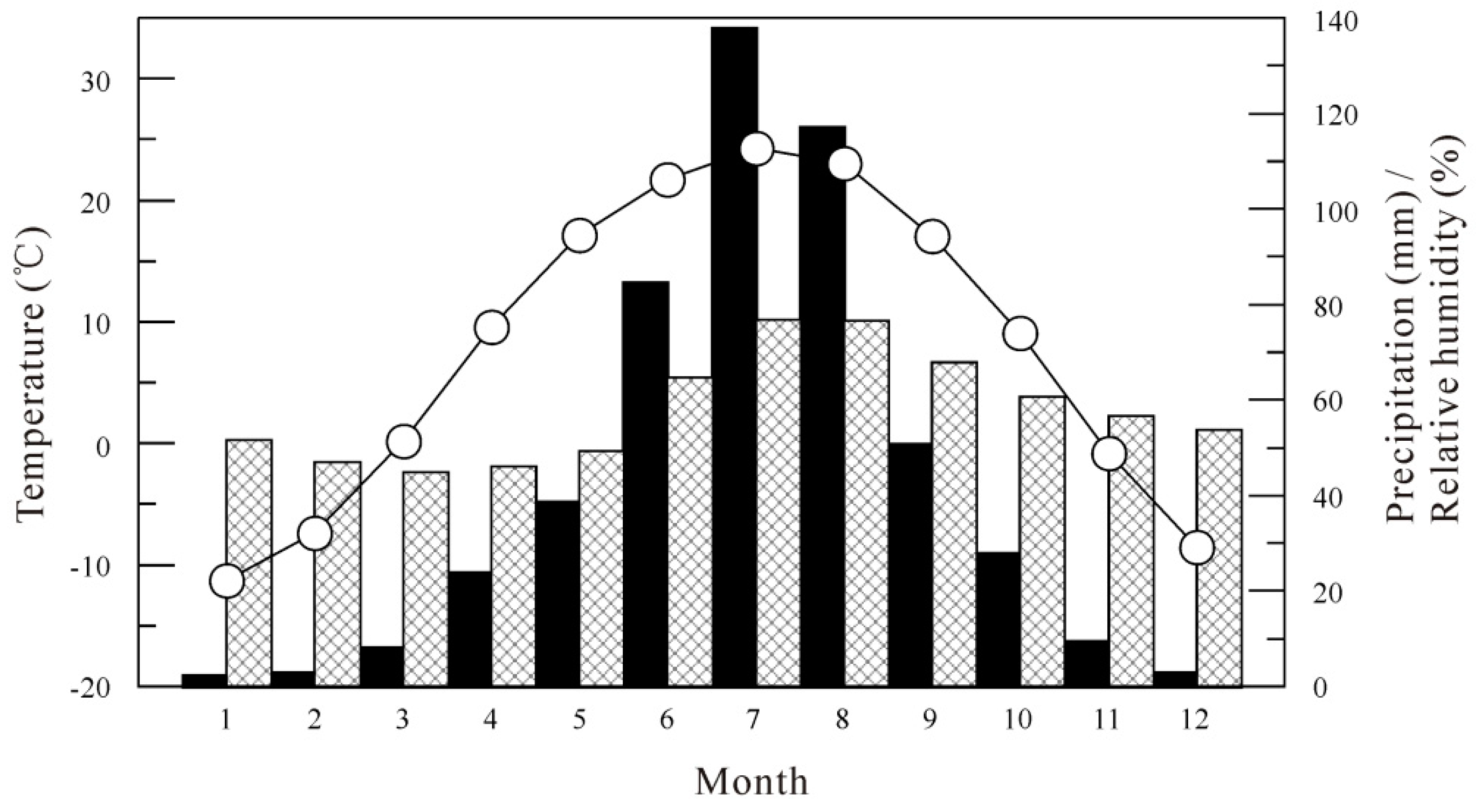

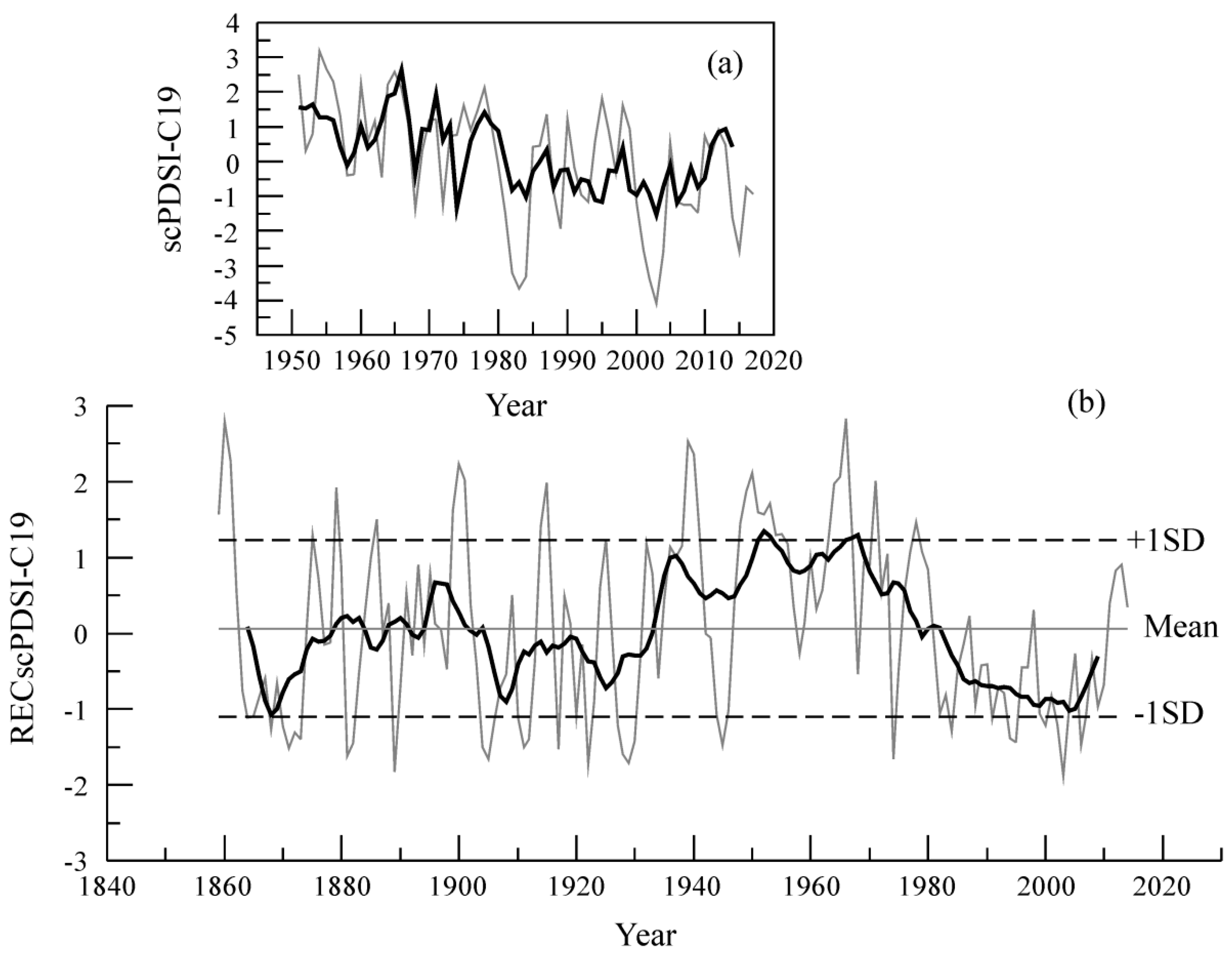
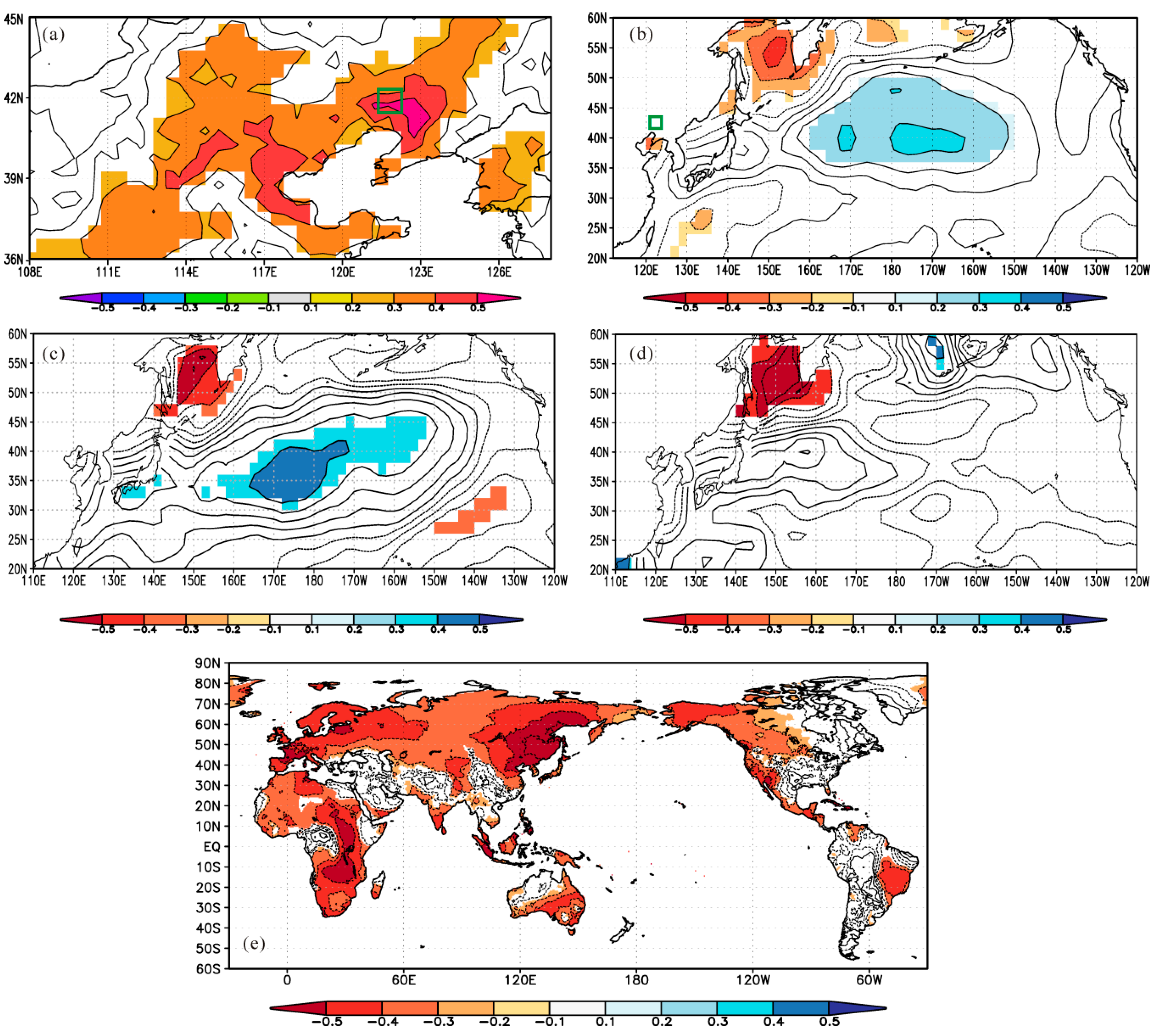

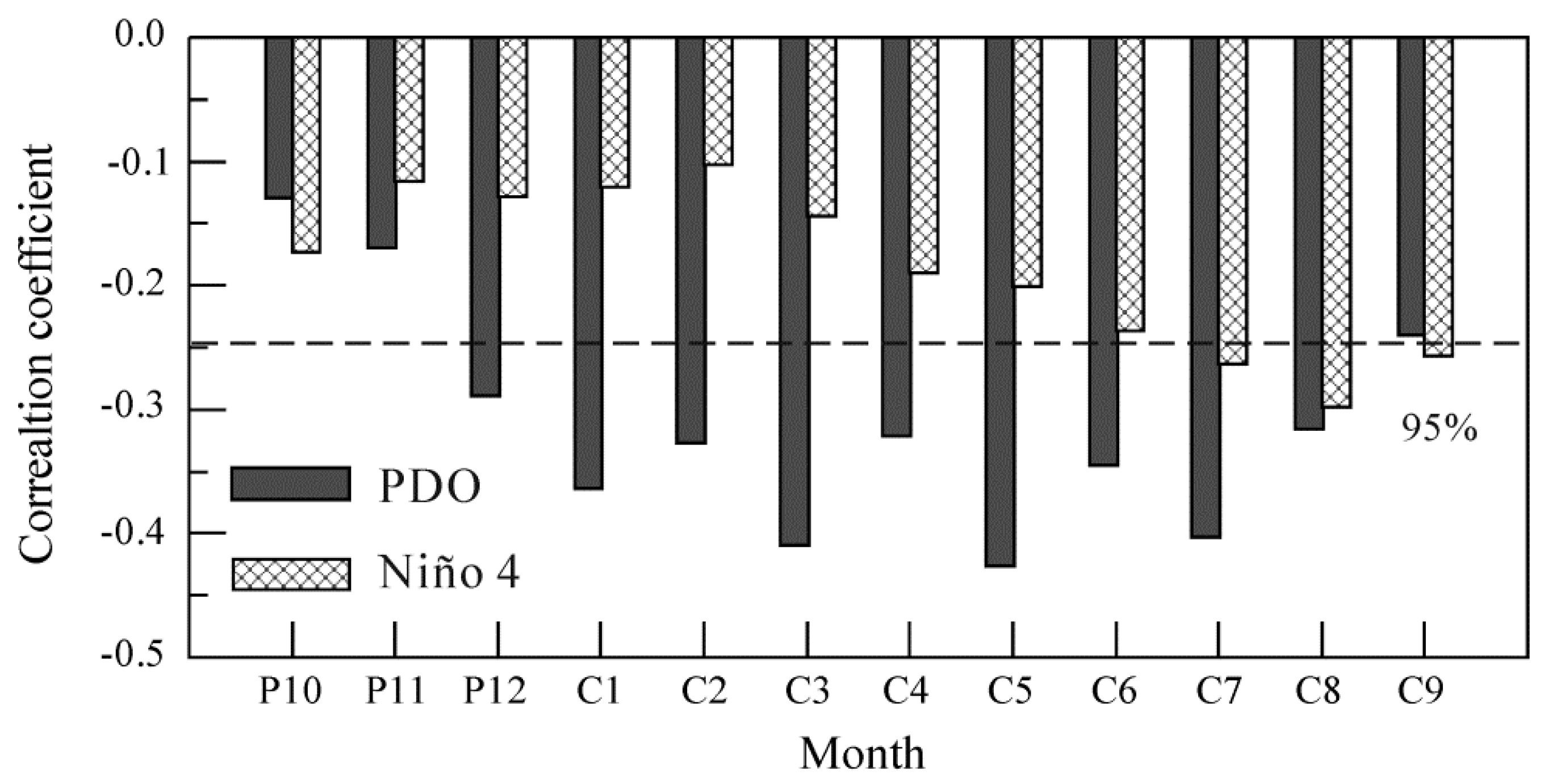
| Statistical Items | SH | WFY |
|---|---|---|
| Mean sensitivity | 0.270 | 0.321 |
| First-order autocorrelation | 0.479 | 0.656 |
| Mean correlation between all series (MCS) | 0.493 | 0.660 |
| Variance in first eigenvector (%) | 53.1 | 53.0 |
| Signal-to-noise ratio (SNR) | 31.194 | 12.804 |
| Chronology length | 1978–2014 | 1849–2014 |
| Month | SH | Month | WFY | ||||||
|---|---|---|---|---|---|---|---|---|---|
| p | T | RH | scPDSI | p | T | RH | scPDSI | ||
| p 10 | 0.094 | 0.084 | 0.336 | 0.427 ** | p 10 | 0.261 * | −0.132 | 0.443 ** | 0.551 ** |
| p 11 | 0.314 | 0.221 | 0.186 | 0.457 ** | p 11 | −0.041 | −0.079 | 0.359 ** | 0.533 ** |
| p 12 | 0.388 * | 0.322 | 0.381 * | 0.465 ** | p 12 | 0.185 | −0.141 | 0.148 | 0.551 ** |
| c 1 | −0.2 | 0.151 | −0.12 | 0.455 ** | c 1 | 0.104 | −0.354 ** | 0.209 | 0.573 ** |
| c 2 | −0.067 | −0.014 | −0.13 | 0.443 ** | c 2 | 0.159 | −0.403 ** | 0.176 | 0.592 ** |
| c 3 | −0.098 | −0.022 | −0.019 | 0.381 * | c 3 | −0.093 | −0.362 ** | 0.175 | 0.570 ** |
| c 4 | −0.031 | −0.142 | 0.078 | 0.385 * | c 4 | −0.058 | −0.488 ** | 0.227 | 0.578 ** |
| c 5 | 0.386 * | −0.465 ** | 0.215 | 0.429 ** | c 5 | 0.087 | −0.314 * | 0.147 | 0.583 ** |
| c 6 | −0.054 | −0.189 | 0.17 | 0.478 ** | c 6 | 0.104 | −0.434 ** | 0.344 ** | 0.583 ** |
| c 7 | 0.174 | −0.183 | 0.334 | 0.472 ** | c 7 | 0.176 | −0.248 | 0.150 | 0.507 ** |
| c 8 | 0.114 | −0.078 | 0.387 * | 0.365 * | c 8 | 0.184 | −0.329 ** | 0.221 | 0.531 ** |
| c 9 | 0.053 | −0.184 | 0.13 | 0.295 | c 9 | 0.004 | −0.455 ** | 0.064 | 0.466 ** |
| c1–9 | 0.210 | −0.187 | 0.204 | 0.469 ** | c1-9 | 0.259 * | −0.638 ** | 0.337 ** | 0.647 ** |
| Calibration | Verification | ||||||||
|---|---|---|---|---|---|---|---|---|---|
| Period | r | R2 | ST | Period | r | R2 | RE | CE | ST |
| 1951–1982 | 0.600 * | 0.360 | 22+/10− | 1983–2014 | 0.462 * | 0.213 | 0.568 | 0.185 | 21+/11− |
| 1983–2014 | 0.462 * | 0.213 | 24+/8− * | 1951–1982 | 0.600 * | 0.360 | 0.695 | 0.334 | 22+/10− |
| 1951–2014 | 0.647 * | 0.419 | 48+/16− * | ||||||
| Rank | Year | Low Value | Year | High Value |
|---|---|---|---|---|
| 1 | 1864 | −1.116 * | 1859 | 1.571 |
| 2 | 1868 | −1.264 * | 1860 | 2.793 ** |
| 3 | 1870 | −1.227 | 1861 | 2.278 ** |
| 4 | 1871 | −1.512 | 1875 | 1.300 ** |
| 5 | 1872 | −1.312 | 1879 | 1.924 ** |
| 6 | 1873 | −1.395 | 1886 | 1.508 ** |
| 7 | 1881 | −1.617 * | 1899 | 1.619 |
| 8 | 1882 | −1.452 | 1900 | 2.232 |
| 9 | 1889 | −1.825 * | 1901 | 2.024 |
| 10 | 1904 | −1.506 * | 1914 | 1.409 |
| 11 | 1905 | −1.663 * | 1915 | 1.981 |
| 12 | 1906 | −1.156 * | 1925 | 1.249 |
| 13 | 1910 | −1.110 | 1939 | 2.537 |
| 14 | 1911 | −1.500 * | 1940 | 2.369 |
| 15 | 1912 | −1.403 * | 1941 | 1.260 |
| 16 | 1917 | −1.532 | 1948 | 1.457 |
| 17 | 1922 | −1.725 | 1949 | 1.862 |
| 18 | 1927 | −1.218 | 1950 | 2.109 ** |
| 19 | 1928 | −1.600 | 1951 | 1.599 ** |
| 20 | 1929 | −1.711 | 1952 | 1.565 |
| 21 | 1930 | −1.426 * | 1953 | 1.716 ** |
| 22 | 1945 | −1.483 | 1954 | 1.289 |
| 23 | 1974 | −1.654 | 1955 | 1.306 ** |
| 24 | 1984 | −1.298 | 1964 | 1.970 |
| 25 | 1991 | −1.127 * | 1965 | 2.058 |
| 26 | 1994 | −1.392 | 1966 | 2.827 |
| 27 | 1995 | −1.443 | 1967 | 1.363 |
| 28 | 2000 | −1.215 | 1971 | 2.013 |
| 29 | 2002 | −1.204 * | 1978 | 1.466 |
| 30 | 2003 | −1.879 | ||
| 31 | 2006 | −1.472 |
© 2019 by the authors. Licensee MDPI, Basel, Switzerland. This article is an open access article distributed under the terms and conditions of the Creative Commons Attribution (CC BY) license (http://creativecommons.org/licenses/by/4.0/).
Share and Cite
Liu, N.; Bao, G.; Bao, M. Response Characteristics of Chinese Pine (Pinus tabulaeformis Carr.) Radial Growth to Climate and Drought Variability Reconstruction in Western Liaoning, Northeast China. Forests 2019, 10, 752. https://doi.org/10.3390/f10090752
Liu N, Bao G, Bao M. Response Characteristics of Chinese Pine (Pinus tabulaeformis Carr.) Radial Growth to Climate and Drought Variability Reconstruction in Western Liaoning, Northeast China. Forests. 2019; 10(9):752. https://doi.org/10.3390/f10090752
Chicago/Turabian StyleLiu, Na, Guang Bao, and Ming Bao. 2019. "Response Characteristics of Chinese Pine (Pinus tabulaeformis Carr.) Radial Growth to Climate and Drought Variability Reconstruction in Western Liaoning, Northeast China" Forests 10, no. 9: 752. https://doi.org/10.3390/f10090752
APA StyleLiu, N., Bao, G., & Bao, M. (2019). Response Characteristics of Chinese Pine (Pinus tabulaeformis Carr.) Radial Growth to Climate and Drought Variability Reconstruction in Western Liaoning, Northeast China. Forests, 10(9), 752. https://doi.org/10.3390/f10090752




